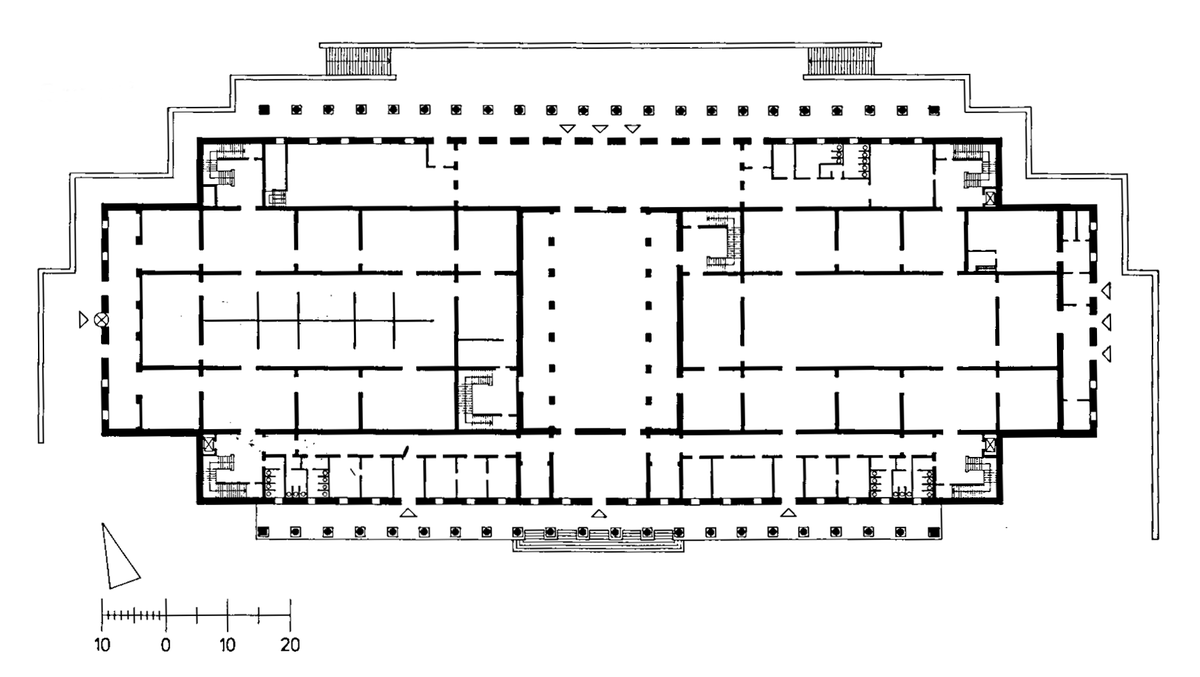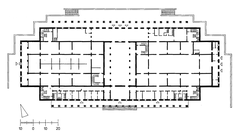
Haus der Kunst Munich: Visiting Hours, Tickets, and Complete Visitor Guide
Date: 14/06/2025
Introduction
Haus der Kunst is one of Munich’s most significant cultural landmarks, uniquely combining a complex historical legacy with an innovative contemporary art program. Standing at the southern edge of the English Garden, this monumental structure has evolved from an emblem of Nazi propaganda to a leading platform for contemporary art and critical reflection. This detailed guide covers Haus der Kunst’s history, architecture, exhibitions, practical visitor information, and essential tips to help you make the most of your visit.
Table of Contents
- Introduction
- History and Significance
- Architecture and Urban Context
- Visiting Haus der Kunst: Key Information
- Addressing the Past: Memory and Responsibility
- The Museum in Contemporary Munich
- Frequently Asked Questions (FAQ)
- Visitor Tips and Nearby Attractions
- Conclusion and Further Resources
- References
History and Significance
Origins and Construction (1933–1937)
Haus der Kunst was constructed between 1933 and 1937 under the direction of architect Paul Ludwig Troost. As the first major architectural project of the Nazi regime, the building was designed to embody ideals of order, permanence, and ideological purity. Its imposing limestone façade, monumental scale, and classical colonnade were meant to project power and authority (Spotting History; Wikipedia).
Nazi-Era Role (1937–1945)
Originally named Haus der Deutschen Kunst, the building opened in 1937 with the “Great German Art Exhibition,” which showcased art aligned with Nazi values and aesthetics. This event was a direct counterpoint to the infamous “Degenerate Art” exhibition, with Adolf Hitler personally curating and approving works that fit the regime’s vision (Spotting History; Grady Newsource). The museum’s spaces were used for propaganda events, including the “Day of German Art,” which featured elaborate parades attended by Nazi officials.
Postwar Transformation (1945–Present)
Following World War II, the building was seized by the American military and used as an officers’ club. During this time, much of the Nazi iconography was removed or concealed, but some architectural remnants remain. By 1946, Haus der Kunst began its transformation into a public exhibition space, gradually shedding its past associations and embracing pluralistic cultural use (Spotting History). Today, the museum is a non-collecting institution that hosts temporary exhibitions by leading contemporary artists from around the world (Broad Street Review; Frieze).
Architecture and Urban Context
Haus der Kunst is a striking example of “totalitarian classicism,” with a façade stretching over 150 meters, massive stone columns, and grand interior galleries. Its scale and symmetry evoke Greco-Roman grandeur, reflecting the regime’s desire for permanence and authority (Wikipedia). Postwar urban changes, such as the removal of the original steps and the addition of trees to obscure the building, reflect Munich’s ongoing negotiation with its architectural legacy.
Since 2013, a major renovation led by architect David Chipperfield has sought to restore original features, reopen skylights, and adapt the building for contemporary use—balancing historical integrity with modern needs (David Chipperfield).
Visiting Haus der Kunst: Key Information
Opening Hours
- Monday, Wednesday, Friday, Saturday, Sunday: 10:00–20:00
- Thursday: 10:00–22:00
- Tuesday: Closed
- Closed on December 24 and 31 (Haus der Kunst Official Website)
Tickets and Admission
- Standard ticket: €12
- Reduced ticket (students, seniors): €8
- Free admission: Children under 18, Munich City Pass holders, and during “Open Haus” (last Friday of each month, 16:00–22:00)
- Tickets can be purchased online or at the museum entrance.
Admission includes a free audio guide in multiple languages.
Accessibility
- Barrier-free access with ramps and elevators
- Wheelchair-accessible restrooms
- Audio guides and sign language tours (on request)
- Assistance available at the information desk (Museen in Bayern)
Getting There
- Address: Prinzregentenstraße 1, 80538 Munich, Germany
- Public transport:
- U-Bahn lines U3/U6 to Universität, then a short walk
- U4/U5 to Max-Weber-Platz (approx. 10-minute walk)
- Tram lines 16/18 nearby
- Parking: Limited; public transport is recommended
(Munich Travel; Destination Munich)
Guided Tours and Educational Offers
- Free audio guides in multiple languages
- Public and private tours (book in advance)
- Family and children’s programs
- Workshops, lectures, and participatory events (Haus der Kunst)
Amenities and Facilities
- Golden Bar: Art deco bar with terrace overlooking the English Garden, offering drinks and light meals (Munich Travel)
- Cloakrooms, accessible restrooms, museum shop, and free Wi-Fi
Current and Upcoming Exhibitions
Haus der Kunst presents a rotating schedule of major exhibitions and interdisciplinary projects:
- “Velvet Terrorism: Pussy Riot’s Russia” (Sep 2024 – Jun 2025)
- Shu Lea Cheang: “KI$$ KI$$” (Feb – Aug 2025)
- Gülbin Ünlü: “Nostralgia” (May 2025 – Feb 2026)
- ars viva 2025: “where will we land?” (Jun – Sep 2025)
- TUNE Series: Monthly music and sound art residencies (Haus der Kunst; Various Others)
Please check the official exhibition calendar for updates and ticketing.
Addressing the Past: Memory and Responsibility
Haus der Kunst actively confronts its origins as a Nazi-era institution through critical exhibitions, archival displays, and educational programming. The “Archive Gallery” offers free access to resources on the building’s history and its transformation, helping visitors understand the significance of art and architecture in shaping public memory (Frieze; Muenchen.de).
The Museum in Contemporary Munich
Today’s Haus der Kunst is recognized for its progressive curatorial approach—emphasizing global, interdisciplinary, and experimental perspectives. Its programming often addresses issues such as post-colonialism, gender, technology, and ecology, positioning the museum at the forefront of contemporary cultural debates (Museen in Bayern; Haus der Kunst – My Art Guides).
The museum’s location near the English Garden and other significant sites, such as the Documentation Centre for the History of National Socialism, enriches the visitor experience by situating art within the broader urban and historical landscape (Munich Travel).
Frequently Asked Questions (FAQ)
Q: What are the Haus der Kunst opening hours?
A: Monday, Wednesday, Friday, Saturday, Sunday: 10:00–20:00; Thursday: 10:00–22:00; Closed Tuesdays.
Q: How much do tickets cost?
A: Standard €12; reduced €8; free for children under 18 and during “Open Haus” (last Friday of the month).
Q: Is the museum wheelchair accessible?
A: Yes, with barrier-free entrances, elevators, and accessible restrooms.
Q: Are guided tours offered?
A: Yes, both public and private tours are available; booking in advance is recommended.
Q: Can I buy tickets on-site?
A: Yes, but online booking is advised for popular exhibitions.
Q: Is photography allowed?
A: Policies vary by exhibition—check signage or ask staff.
Q: Are there food and beverage options?
A: Yes, the Golden Bar is located within the museum.
Visitor Tips and Nearby Attractions
- Plan ahead: Check the official website for current exhibitions and ticketing.
- Visit during “Open Haus”: Last Friday of each month offers free admission from 16:00–22:00.
- Combine with other sites: The English Garden, Eisbach wave, and Documentation Centre for the History of National Socialism are all nearby.
- Arrive early or late: Weekday mornings and Thursday evenings are quieter.
- Leverage free Wi-Fi and digital guides: Enhance your visit with online resources.
- Accessibility: Staff are available to assist visitors with special needs.
Conclusion and Further Resources
Haus der Kunst Munich represents a profound intersection of history, art, and societal reflection. As both a monument to a difficult past and a beacon of progressive culture, it invites visitors to engage with the complexities of art, memory, and social responsibility. Stay connected by subscribing to the museum newsletter, downloading the Audiala app for interactive guides, and following Haus der Kunst on social media for the latest updates.
For more on Munich’s art and historical sites, explore related articles on our website.
References and Official Resources
- Spotting History: Haus der Kunst
- Grady Newsource: 70 years later, Munich’s House of Art still houses war wounds
- Broad Street Review: Munich’s Haus der Kunst and Hitler’s Art Legacy
- Frieze: How Munich’s museums are confronting their Nazi history
- Wikipedia: Haus der Kunst
- Haus der Kunst Official Website: Plan Your Visit
- Munich Travel: Haus der Kunst
- Museen in Bayern: Haus der Kunst





































































































